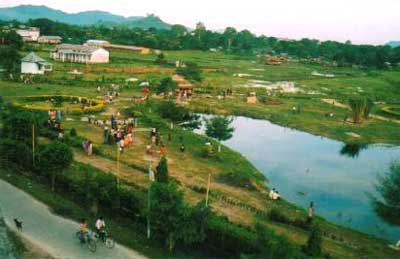| Encyclopedia of Tours and Travel to Assam, featuring information on Fairs & Festivals, Wildlife, Excursion, Adventure and Weather of Assam. |
 |
 |
 |
 |
 |
 |
 |
 |
|
|
Bongaigaon
 The decision of the Government of Assam in 1989, to create a new District of Bongaigaon curving out some areas of the Goalpara and Kokrajhar District with its headquarter located at Bongaigaon was quite challenging. It was the political and administrative exigencies which had necessitated to create this new district suddenly although the people of Bongaigaon and the adjoining areas were demanding a new Sub-Division with its headquarter to be located at Bongaigaon from the very beginning. This decision to create a new District, Bongaigaon was quite challenging because the very idea to create such a district was neither a long standing one nor a tested one. Moreover, the decision to set up a district headquarter at Bongaigaon was more challenging as there was no Sub-divisional infrastructure in this town, whereas the other newly created district head quarters of Assam had Sub-divisional infrastructures of their own. In the absence of such basic infrustructural facilities, the initiation of the activity of the district headquarter was almost started on the street, which was not only challenging task but also novel one. Excursion Bageswari Temple
Rock Cut Caves This Cave measures 2.60 m breadth ,1.8 metre in depth and 1.90 metre in height and also a roughly rounded ceiling and in front a verandah 75 cm long by 35 cm broad. A platform of brick and mud masonry is found inside which is obviously a later addition. A chase running across the entire breath of the cave on the top serves to drain away rain water from the facade. Flights of steps have been cut into the rock on either side and ledge on the top diverts the rain water from the facade. The cave bears no sculptural designs. The other caves at the site have no flights and verandah and smaller in size than the best preserved one. This architectural site has been taken up by the Archaelogical survey of India for preservation. The Lalmati-Duramari Ganesh Temple There are three views advanced as the reason for destrcution of
the temple .The first view has it that eartquakes during the 8th
and 10th centuries destroyed the temple and its images, while according
to tyhe second view, Kalapahar who revolted against worshipers and
priests, destroyed the temple along with other temples and images
in the North-East. The third view has it that Burmese(Maan) invaders
who camped at Malegarh(Manegarh) hills destroyed the temple along
with the idols. But it seems that eartquake has been the prime cause
of the destruction of the temple.
|
||||||||||
|
||||||||||
| 2021 Copyrights | bharatheritage.in |